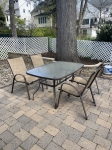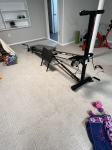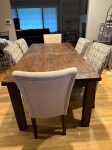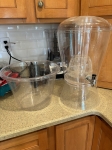Interior door repair
I know you weren't looking for DIY advice, but just in case... I've fixed many of the hinge mounts in our 90 year old house using auto body filler (Bondo) mixed with some saw dust or additional talc. Basically, mix it up per the instructions on the can, stir in some sawdust or talc (just makes the mix a little less dense and easier to drill into), dump the mix into a plastic baggie, and cut off the corner of the baggie. You now have a cake bag for bondo. Squirt it into the oversized screw holes and tamp down with a dowel to make sure it's packed into the hole. When it dries, you can drill it like the original wood and go back to using the correct screws (probably about a #10 brass screw in older houses).
jmc said:
Our interior doors are reaching the point where they need assistance. The jambs are out of true and the hinges have been drilled so many times a 3.5 inch screw isn't holding it in. I think I need some sort of carpenter, has anyone done this work and can recommend someone
I've done this hinge repair by drilling a hole large enough for a wooden peg. Glue the peg in place, sand when dry, then re-hang the hinge.
http://johnyoungs.com/handyman/stripped_master_bedroom_door_hinge_repair.shtml
Forget all that. Stick a wooden toothpick in the hole, break it off so that it doesn't stick out, put the screw back in.
Unfortunately on the door that's in the worst shape we've plugged the hole with dowels a few times, I think it's gone beyond that phase. The Bondo is new, we can investigate. At this point though we're just willing to have someone else do it
Dowels (toothpicks, golf tees, etc.) only works if the hole is somewhat uniformly oversized AND the jamb is uniformly thick. Many jambs are made of several layers with voids between the layers. Bondo (or wood filler) has the advantage that it flows into the surrounding material and creates a fairly uniform substrate. I've rebuilt badly damaged window frames with this approach, and it's far superior to anything involving Elmer's glue and splinters.
jmc said:
Unfortunately on the door that's in the worst shape we've plugged the hole with dowels a few times, I think it's gone beyond that phase. The Bondo is new, we can investigate. At this point though we're just willing to have someone else do it
We used Wilber's Carpentry for the exact problem described in the original post. Excellent job.
I just remedied the same issue on two of our doors by using epoxy injector (less than $5 from HD) into the holes, letting it set for a minute and reinserting the screws through the hinge right back into the old hole. 15 minutes set time and they have been working fine for the last month.
My husband is a carpenter/handyman and can tackle this type of work. Cristian Valerio ValeriosContracting@gmail.com or 973-943-6742.
For Sale
-
REVO luggage $100
More info
Free Items
Sponsored Business
Promote your business here - Businesses get highlighted throughout the site and you can add a deal.
















Our interior doors are reaching the point where they need assistance. The jambs are out of true and the hinges have been drilled so many times a 3.5 inch screw isn't holding it in. I think I need some sort of carpenter, has anyone done this work and can recommend someone